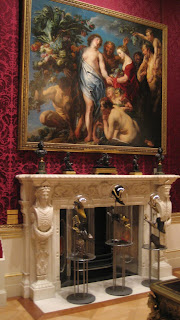Instead of the usual E.A.S.T meeting today we invited artist, Vinny Stapley to take the group through some design exercises. We arrived at the hall at Braintree District Museum to find Vinny putting together a still life - dried foliage, exotic vegetables and interesting lighting.
We began with some warm up exercises. Using charcoal, first we had to draw with our non-dominant hand. We had about 8 minutes to make our drawing.
Then we had to draw without looking at our paper - I really struggled not to look, and did not take a photo of this exercise. Our final warm up exercise was to put our paper on the floor and then draw with our charcoal attached to a very long stick.
We had time for a group critique before our next exercise.
Then we moved on to working in colour - in a section Vinny called the 'magic roundabout'. For each 'station' Vinny placed a different type of media. Each activity was timed - about 5 or 8 minutes for each. Then we moved to the seat on our left and picked up the next media. As we moved along we also moved around the central still life - so our view changed. We were supposed to capture moments - and think about what was being left out.
Sometimes I built on an image I had already started - sometimes I tried something completely new. A different fruit perhaps - but I kept coming back to the dried teasels and what I think was cow parsley.
Then we used some card windows to pick out sections - something we could develop.
For the final session of the day we worked in groups to create a 3-dimensional response to the central still life. Again we were time limited and had to use materials that were to hand. I worked with Felicity and Libby to create this response to the pumpkin and cow parsley florets, with a 'box' (made from paper) - a juxtaposition of the natural and man made. The title of the workshop was 'organic subversive' and we felt that this would also be the title for our finished 'sculpture'. Oh - and we decided to add a little humour as Libby's glasses were just the perfect colour.
The importance of lighting was discussed as we looked at the sculptures by the others in the group.
All in all it was a really interesting day. I was really pushed to do work I haven't done for ages - in particular drawing, but also using natural objects for inspiration and working with some new types of media. There were quite a few pieces that I was very pleased with, and I think can be developed further. I am also wondering if I can combine anything from today with the work from the workshop I did with Diane Bates.
Watch this space!












































